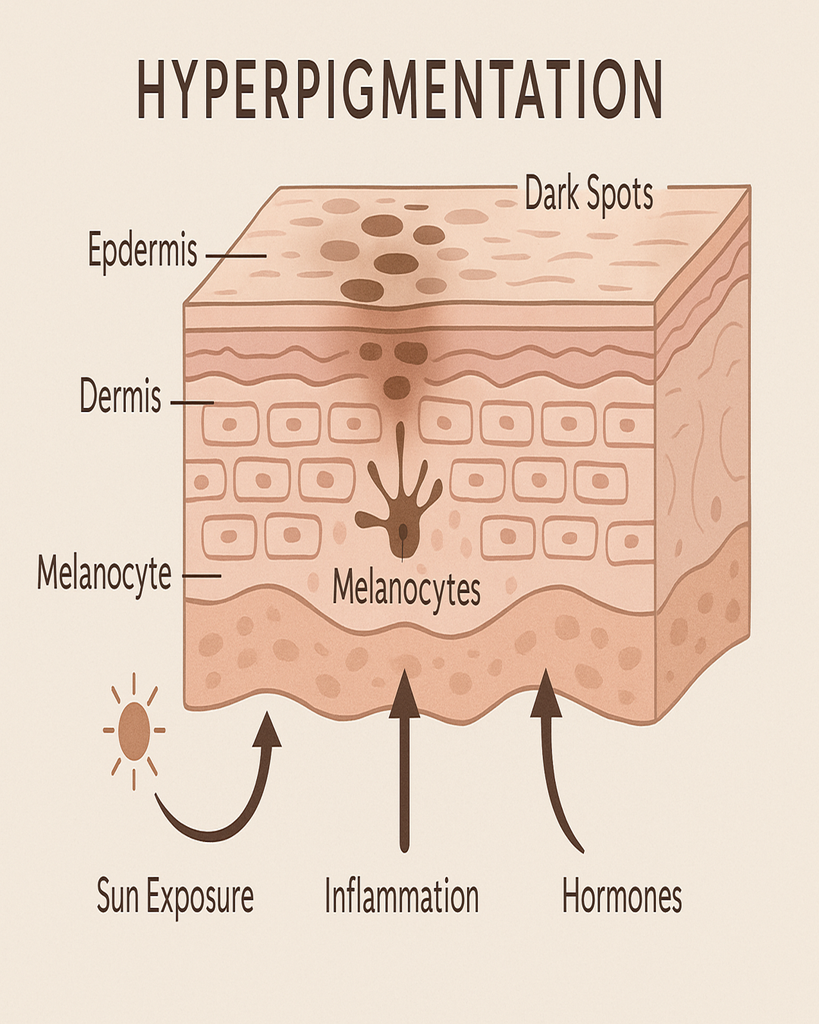Melasma vs Hyperpigmentation: A Phased, Holistic Approach for Healthier, More Even Skin

Melasma, hyperpigmentation, and age spots are often spoken about interchangeably, but they’re not quite the same thing. Understanding these differences is key to choosing the right treatment approach and setting realistic expectations.
Hyperpigmentation is a broad term for any area of skin that becomes darker than the surrounding tissue due to excess melanin. This can happen after inflammation like acne, eczema, injury, or it can develop over time as freckles and sun spots from cumulative UV exposure.
Melasma is a specific form of hyperpigmentation. It often appears as larger, patchy areas on the cheeks, forehead, upper lip, or neck. It’s more common in women and is closely linked to hormonal changes, thyroid imbalances, stress, and sun exposure. Unlike freckles or post-acne marks, melasma tends to be chronic because the pigment cells are highly reactive and easily triggered.
Age spots, also known as solar lentigines, are flat brown spots that typically appear on areas that have had years of sun exposure, like the face, chest, and hands. They’re not harmful, but they’re another visible sign of UV damage over time.
It’s important to remember that pigmentation often takes years, sometimes decades, to become visible on the surface. The deeper the pigmentation is within the skin, the longer it can take to reduce. This is why lasting results come from steady, consistent treatment rather than quick fixes.
Why Some Products Work So Fast (and Why the Results Don’t Last)
You’ve probably seen skincare brands on social media showcasing dramatic before-and-after photos for fading dark spots. Often, the key ingredient behind those results is hydroquinone, a strong pigment-lightening agent. Hydroquinone works by blocking melanin production, which can make discoloration fade rapidly.
While this can be appealing, hydroquinone is banned in Europe due to potential health risks and concerns about long-term safety. Another major drawback is that once you stop using it, pigmentation often comes back, especially with melasma. This rebound effect happens because the underlying triggers haven’t been addressed. Relying on quick fixes can also make the skin more vulnerable and less resilient over time.
A Phased, Health-First Approach to Treating Brown Spots
Lasting change happens when you work with your skin, not against it. A thoughtful, phased approach supports skin health while gradually fading discoloration without causing damage.
Phase 1: Strengthen and Support
Healthy skin can better tolerate active ingredients and respond more effectively to treatment. The goal in this phase is to calm inflammation, repair damage, and strengthen the barrier.
Veologē Protocol:
-
Youth Serum – Infused with vitamin C to boost radiance and deliver antioxidant protection, helping prepare the skin for brightening ingredients.
-
Antioxidant Cream – Contains vitamins C, E, B5, MSM, and antioxidant-rich ingredients like astaxanthin, blueberry extract, and orange peel extract to help repair damaged skin cells and support barrier resilience.
-
Daily SPF 30+ – Essential to prevent further pigment formation and protect against UV-induced triggers.
This foundation phase ensures that your skin is balanced and healthy, setting the stage for brighter, more even skin tone over time.
Phase 2: Brighten with Gentle, Effective Ingredients
Once your skin is supported, it’s time to target excess pigment through gentle exfoliation and brightening actives. Look for ingredients that calm overactive melanocytes rather than shocking them into submission.
-
Licorice root naturally brightens and soothes
-
Reishi mushroom helps calm inflammation and support repair
-
Bioavailable vitamin C protects against oxidative stress and boosts radiance
-
Glycolic, lactic, and malic acids encourage smoother, more even skin tone
Veologē Protocol:
-
Glycolic Serum – A powerful yet gentle blend of glycolic, lactic, and malic acids that resurfaces the skin, improves texture, and helps lift pigment from the surface.
-
Enzyme Exfoliator – Combines Reishi mushroom, willow bark, papaya enzymes, and glycolic acid to refine the skin and enhance penetration of brightening ingredients.
-
Tripeptide Eye Gel (optional add-on) – Targets uneven tone around the eyes with licorice root extract while firming and hydrating the delicate skin.
Because pigmentation can be deep within the skin, this phase requires patience and consistency. Gradual improvement is far more sustainable than aggressive, fast-acting methods that can lead to irritation or rebound pigmentation.
Phase 3: Protect with Antioxidants — Topical and Internal
Protection is essential for keeping pigmentation from returning. Environmental stressors like UV rays and pollution can stimulate melanin production, so daily antioxidant protection acts as a shield for your skin.
Veologē Protocol:
-
Continue Antioxidant Cream – Formulated with vitamins C, E, B5 and antioxidants to help neutralize environmental stress, support cellular repair, and maintain a more even tone.
-
Daily SPF 30+ – Reinforces this protective layer and helps prevent new pigment from forming.
Topical protection is complemented by what you put on your plate. Eating a variety of colorful fruits and vegetables adds antioxidants to your system from the inside out. Berries, leafy greens, and vibrant produce naturally defend their own cells from UV and pollution, and they offer your skin similar protection. This internal support amplifies the benefits of your topical routine, creating a stronger overall defense against pigmentation triggers.
The Veologē Way: Thoughtful, Consistent, Holistic
Melasma and hyperpigmentation don’t appear overnight, and they won’t disappear overnight either. Every skin story is unique, and factors like internal health, hormones, and lifestyle can influence how pigmentation responds to treatment. For some, discoloration can be greatly reduced, while for others it may soften but not fully disappear. A consistent, thoughtful approach can support meaningful improvements over time.
